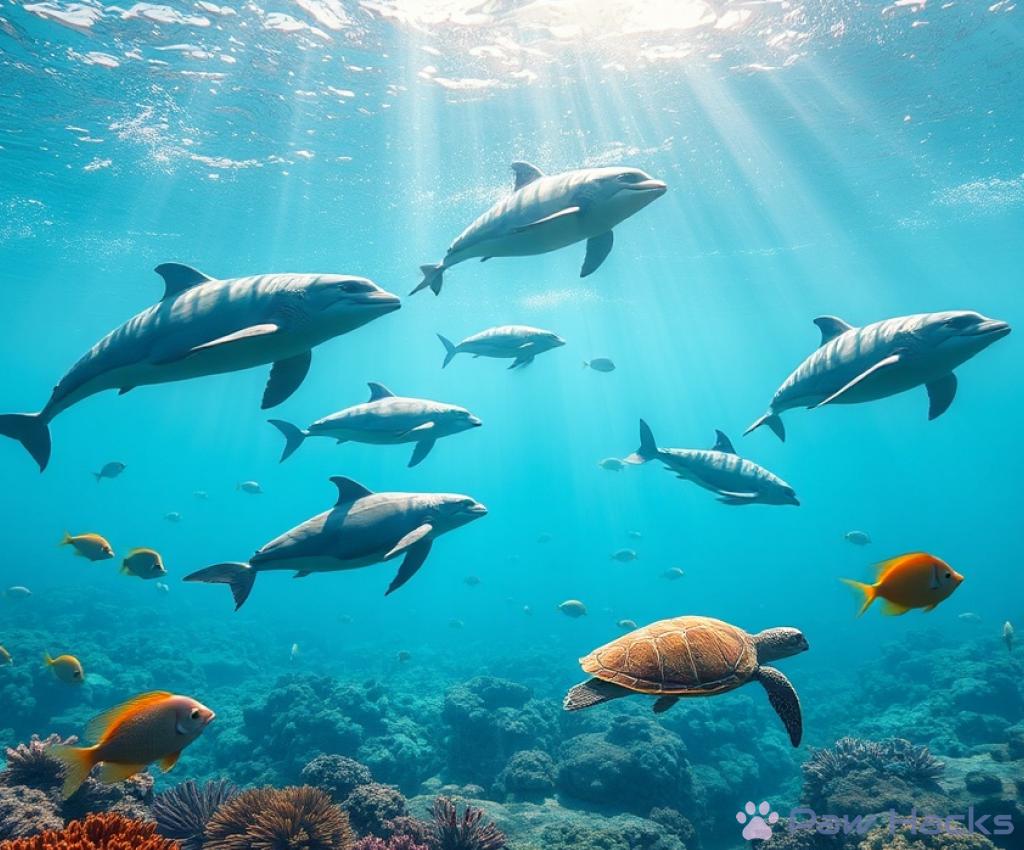Rescuing Aquatic Animals
Saving Our Oceans: The Urgent Need for Aquatic Animal Rescue

Our oceans are home to a spectacular array of life, from the tiniest plankton to the majestic whales. However, these aquatic ecosystems are under severe threat due to pollution, climate change, and overfishing. Understanding the urgent need for aquatic animal rescue is crucial for preserving these vital habitats and the species that inhabit them.
Every year, millions of marine animals face life-threatening situations due to human actions. Whether it’s entanglement in fishing gear, ingestion of plastic, or habitat destruction, these challenges require immediate attention and action. In this article, we will explore the various aspects of aquatic animal rescue and why it is essential for our planet’s health.
Aquatic animals face numerous threats that endanger their survival. By identifying these causes, we can better understand the necessity for rescue operations and protective measures.
- Pollution: Plastics and chemicals contaminate water bodies, leading to ingestion and poisoning of marine life.
- Climate Change: Rising temperatures and ocean acidification disrupt ecosystems and threaten species survival.
- Overfishing: Unsustainable fishing practices deplete fish populations and harm the entire marine food web.
- Habitat Loss: Coastal development and pollution destroy vital habitats like coral reefs and mangroves.
Addressing these issues requires coordinated efforts from governments, NGOs, and local communities to implement effective rescue and rehabilitation programs.
Rescue organizations play a pivotal role in protecting aquatic animals and restoring their habitats. They work tirelessly to rescue, rehabilitate, and release marine creatures affected by human activities.
Here’s how these organizations contribute to the conservation of our oceans:
- Rescue Operations: Teams are trained to respond quickly to reports of stranded or injured marine animals.
- Rehabilitation Programs: Injured animals receive medical treatment and care to prepare them for release back into the wild.
- Public Education: Many organizations focus on educating the public about marine conservation and responsible behavior toward the ocean.
- Research and Monitoring: Ongoing research helps track animal populations and the effectiveness of conservation strategies.
By supporting these organizations, we can make a significant impact on preserving aquatic life and ensuring future generations can enjoy healthy oceans.
The Heroes of the Sea: Meet the Rescuers of Aquatic Wildlife
In the vast expanse of our oceans, a dedicated group of individuals and organizations rise to the challenge of saving aquatic wildlife. These passionate rescuers embody the spirit of compassion and commitment, often putting their own lives at risk to help marine animals in distress. Their efforts are not only critical for individual species but also play an essential role in the health of our entire ocean ecosystem.
Every day, these heroes face numerous challenges, from navigating treacherous waters to dealing with the aftermath of human-induced disasters. Their work is a testament to the power of human determination and the willingness to protect our planet’s most vulnerable inhabitants.
Among the ranks of these aquatic heroes are marine biologists, veterinarians, volunteers, and activists, all of whom bring unique skills to the table. For instance, marine biologists conduct vital research that informs rescue strategies, while veterinarians provide essential medical care to injured animals. Volunteers often assist with rescue operations, bringing in an extra layer of support and enthusiasm.
One remarkable organization, Ocean Guardians, is known for its rapid response to emergencies involving stranded marine mammals. With a team of experts trained to handle everything from beached whales to entangled dolphins, they exemplify what it means to be a hero of the sea. Their work not only saves lives but also raises awareness about the importance of marine conservation.
The challenges faced by aquatic wildlife are complex and often require collaborative solutions. Rescuers often partner with government agencies, NGOs, and local communities to maximize their impact. By pooling resources and expertise, these collaborations enhance the effectiveness of rescue operations and lead to more sustainable conservation practices.
For instance, during a recent oil spill, multiple organizations came together to create a comprehensive response plan. This included everything from immediate rescue efforts to long-term rehabilitation of affected species. Such teamwork not only facilitates more successful rescues but also promotes a sense of community responsibility towards marine life.
In addition to direct rescue efforts, many organizations also focus on public education. By raising awareness about the challenges aquatic animals face, they empower individuals to make informed decisions that benefit the ocean. Every person can be a hero by practicing responsible behavior, such as reducing plastic usage and supporting sustainable seafood choices.
From Pollution to Protection: How We Can Help Aquatic Animals Thrive
As the guardians of our oceans, we hold the power to turn the tide for aquatic animals that are struggling to survive amidst pollution and habitat destruction. Each small action we take can contribute to a larger movement aimed at safeguarding these vital ecosystems. By understanding how pollution affects marine life and learning ways to protect their habitats, we can become advocates for a healthier ocean.
Every one of us can play a role in reducing pollution. Simple changes in our daily routines can lead to significant improvements in the health of our oceans. For instance, by reducing single-use plastics, we can minimize the amount of waste that ends up in marine environments. Choosing reusable bags, bottles, and containers not only cuts down on plastic consumption but also sets a positive example for others. Additionally, participating in local clean-up events can directly benefit marine habitats while fostering community engagement.
Being informed is just as crucial as taking action. By educating ourselves and sharing knowledge about the impacts of pollution on marine life, we can inspire others to join the cause. This can be done through social media campaigns, hosting workshops, or collaborating with local schools to implement marine conservation programs. Knowledge is a powerful tool that can shift perceptions and encourage responsible behaviors toward our oceans.
Moreover, advocating for policy changes that promote sustainable practices is vital. Engaging with policymakers and supporting legislation aimed at reducing pollution can create a ripple effect, leading to broader systemic changes that benefit marine environments. Every voice counts, and collective advocacy can lead to significant advancements in ocean protection.
While individual actions are important, they must be complemented by the efforts of conservation organizations that work tirelessly to protect aquatic animals. These organizations conduct essential research, rehabilitation, and advocacy work to safeguard marine ecosystems. They often collaborate with local communities to promote sustainable fishing practices and habitat restoration initiatives. By supporting these organizations through donations or volunteering, we can amplify our impact and contribute to the ongoing efforts to rescue aquatic animals.
In conclusion, the journey from pollution to protection begins with us. By making conscious choices, spreading awareness, and supporting dedicated conservation efforts, we can help aquatic animals not just survive, but thrive. Together, we can create a future where our oceans are vibrant, diverse, and full of life.
Innovative Solutions: Technology’s Role in Aquatic Animal Rescue
As we continue to face the pressing challenges of marine conservation, technology has emerged as a powerful ally in the fight to rescue aquatic animals. The integration of innovative tools and techniques into rescue operations is revolutionizing how rescuers respond to emergencies and rehabilitate injured marine life. By harnessing the potential of technology, we can enhance our effectiveness in protecting vulnerable species and restoring their habitats.
One of the most significant advancements in aquatic animal rescue is the use of drones and remote sensing technologies. These devices allow rescue teams to conduct aerial surveys of coastlines and open waters, identifying stranded or injured animals quickly and efficiently. For instance, drones equipped with high-resolution cameras can cover large areas in a fraction of the time it would take on foot or by boat. This rapid response capability is crucial, as it can mean the difference between life and death for many marine creatures.
Moreover, GPS tracking devices are being utilized to monitor the movements of rescued animals post-release. This technology provides valuable data on their recovery and adaptation in the wild, helping researchers understand their behavior and the effectiveness of rehabilitation efforts. By analyzing this information, scientists can refine rescue strategies and improve future interventions.
In the realm of rehabilitation, technological innovations are transforming how injured aquatic animals receive care. Facilities are now integrating telemedicine into their practices, allowing veterinarians to consult with specialists remotely. This capability ensures that injured animals receive timely and expert medical attention, regardless of location.
Furthermore, 3D printing technology is making waves in the creation of prosthetics for injured marine animals. From turtles with missing flippers to dolphins recovering from severe injuries, 3D-printed solutions provide customized support that can significantly enhance their quality of life. These innovative approaches showcase our ability to blend compassion with cutting-edge technology to benefit aquatic wildlife.
As we embrace these technological advancements, it’s essential to remember that they complement the unwavering dedication of the human rescuers behind them. The collaboration between technology and skilled professionals is paving the way for more effective and humane rescue operations, ultimately leading to healthier oceans and thriving aquatic populations.
Community Action: How Local Efforts Make a Big Impact on Aquatic Life
When it comes to rescuing aquatic animals, the power of community action cannot be overstated. Local initiatives often serve as the backbone of conservation efforts, bringing together passionate individuals who are dedicated to protecting marine life. These grassroots movements not only foster awareness but also create a significant impact on aquatic ecosystems. By participating in local efforts, communities can play a crucial role in ensuring the health and safety of marine species.
Across the globe, community-driven conservation projects are gaining momentum. These initiatives often arise from a deep-rooted love for the ocean and its inhabitants. Community members band together to tackle pressing issues such as pollution, habitat destruction, and the plight of endangered species. The collaborative spirit of these movements allows them to address local challenges effectively, fostering a sense of ownership and responsibility towards marine ecosystems.
There are numerous ways local communities can contribute to the rescue of aquatic animals. Below is a list of impactful actions that individuals and organizations can take:
- Beach Cleanups: Organizing regular cleanups can significantly reduce debris and plastics that threaten marine life.
- Awareness Campaigns: Holding workshops and informational sessions can educate the public about the importance of marine conservation.
- Partnerships with NGOs: Collaborating with non-profit organizations can amplify the impact of local efforts through shared resources and expertise.
- Advocacy for Policy Change: Engaging with local governments to promote sustainable practices can lead to effective environmental policies.
- Wildlife Monitoring Programs: Involving volunteers in monitoring local marine wildlife provides vital data for conservation strategies.
To understand the effectiveness of community actions, it’s essential to measure their outcomes. Many local initiatives have successfully led to healthier marine environments. For instance, areas that have seen a reduction in plastic waste often report increased populations of marine species. By tracking these changes, communities can assess the direct correlation between their efforts and the recovery of local aquatic life.
As communities continue to rally together for the cause of aquatic animal rescue, their collective actions serve as a beacon of hope. The commitment of local groups not only aids in immediate rescue efforts but also fosters a long-term culture of ocean stewardship. With every small action, communities are helping to create a brighter future for our oceans and the creatures that inhabit them.
Share this content:



